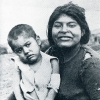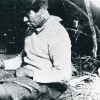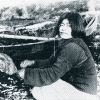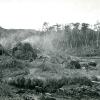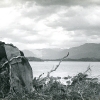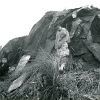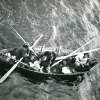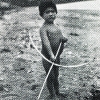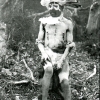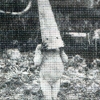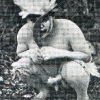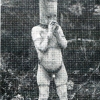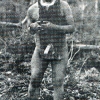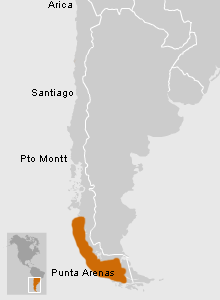The Kawésqar’s traditional territory extended from the Gulf of Penas roughly to the Cockburn Channel in western Tierra del Fuego, and included the Strait of Magellan as far as the southern end of the Sarmiento Channel. This is the region of Chile’s labyrinthine southern archipelago, where the Andes mountains are almost impenetrable and the islands difficult to land upon, with few beaches and dense woodlands reaching right to the water’s edge. The sea channels, about 480km (300 miles) long, are generally calm and easily navigable. The climate is cold and rainy, with the year divided into just two seasons: winter, with temperatures between 0 and -5°C (23 to 32°F), and summer, with highs of around 10°C (50°F).
The Kawésqar’s traditional territory extended from the Gulf of Penas roughly to the Cockburn Channel in western Tierra del Fuego, and included the Strait of Magellan as far as the southern end of the Sarmiento Channel. This is the region of Chile’s labyrinthine southern archipelago, where the Andes mountains are almost impenetrable and the islands difficult to land upon, with few beaches and dense woodlands reaching right to the water’s edge. The sea channels, about 480km (300 miles) long, are generally calm and easily navigable. The climate is cold and rainy, with the year divided into just two seasons: winter, with temperatures between 0 and -5°C (23 to 32°F), and summer, with highs of around 10°C (50°F).
The Kawésqar’s traditional territory extended from the Gulf of Penas roughly to the Cockburn Channel in western Tierra del Fuego, and included the Strait of Magellan as far as the southern end of the Sarmiento Channel. This is the region of Chile’s labyrinthine southern archipelago, where the Andes mountains are almost impenetrable and the islands difficult to land upon, with few beaches and dense woodlands reaching right to the water’s edge. The sea channels, about 480km (300 miles) long, are generally calm and easily navigable. The climate is cold and rainy, with the year divided into just two seasons: winter, with temperatures between 0 and -5°C (23 to 32°F), and summer, with highs of around 10°C (50°F).
The Kawésqar’s traditional territory extended from the Gulf of Penas roughly to the Cockburn Channel in western Tierra del Fuego, and included the Strait of Magellan as far as the southern end of the Sarmiento Channel. This is the region of Chile’s labyrinthine southern archipelago, where the Andes mountains are almost impenetrable and the islands difficult to land upon, with few beaches and dense woodlands reaching right to the water’s edge. The sea channels, about 480km (300 miles) long, are generally calm and easily navigable. The climate is cold and rainy, with the year divided into just two seasons: winter, with temperatures between 0 and -5°C (23 to 32°F), and summer, with highs of around 10°C (50°F).
The Kawésqar’s traditional territory extended from the Gulf of Penas roughly to the Cockburn Channel in western Tierra del Fuego, and included the Strait of Magellan as far as the southern end of the Sarmiento Channel. This is the region of Chile’s labyrinthine southern archipelago, where the Andes mountains are almost impenetrable and the islands difficult to land upon, with few beaches and dense woodlands reaching right to the water’s edge. The sea channels, about 480km (300 miles) long, are generally calm and easily navigable. The climate is cold and rainy, with the year divided into just two seasons: winter, with temperatures between 0 and -5°C (23 to 32°F), and summer, with highs of around 10°C (50°F).
The Kawésqar’s traditional territory extended from the Gulf of Penas roughly to the Cockburn Channel in western Tierra del Fuego, and included the Strait of Magellan as far as the southern end of the Sarmiento Channel. This is the region of Chile’s labyrinthine southern archipelago, where the Andes mountains are almost impenetrable and the islands difficult to land upon, with few beaches and dense woodlands reaching right to the water’s edge. The sea channels, about 480km (300 miles) long, are generally calm and easily navigable. The climate is cold and rainy, with the year divided into just two seasons: winter, with temperatures between 0 and -5°C (23 to 32°F), and summer, with highs of around 10°C (50°F).
The Kawésqar’s traditional territory extended from the Gulf of Penas roughly to the Cockburn Channel in western Tierra del Fuego, and included the Strait of Magellan as far as the southern end of the Sarmiento Channel. This is the region of Chile’s labyrinthine southern archipelago, where the Andes mountains are almost impenetrable and the islands difficult to land upon, with few beaches and dense woodlands reaching right to the water’s edge. The sea channels, about 480km (300 miles) long, are generally calm and easily navigable. The climate is cold and rainy, with the year divided into just two seasons: winter, with temperatures between 0 and -5°C (23 to 32°F), and summer, with highs of around 10°C (50°F).
The Kawésqar’s traditional territory extended from the Gulf of Penas roughly to the Cockburn Channel in western Tierra del Fuego, and included the Strait of Magellan as far as the southern end of the Sarmiento Channel. This is the region of Chile’s labyrinthine southern archipelago, where the Andes mountains are almost impenetrable and the islands difficult to land upon, with few beaches and dense woodlands reaching right to the water’s edge. The sea channels, about 480km (300 miles) long, are generally calm and easily navigable. The climate is cold and rainy, with the year divided into just two seasons: winter, with temperatures between 0 and -5°C (23 to 32°F), and summer, with highs of around 10°C (50°F).
How to Arrive
El Museo se encuentra ubicado en pleno centro de Santiago, en la esquina de las calles Bandera y Compañía, a una cuadra de la Plaza de Armas.
Tickets
Chileans and resident foreigners: $1,000 Foreigners: $8,000 Chilean students and resident foreigners: $500 Foreign students: $4,000
Guided Visit
El Museo cuenta con un servicio de guías, sin costo adicional, para los establecimientos educacionales.
Information for Teachers
Invitamos especialmente a coordinarse con alguno de nuestros guías para programar una visita o actividades de motivación y seguimiento que aprovechen de la mejor forma la experiencia de visitarnos.
Audioguides
Download recordings of the Permanent Exhibition display texts in English, French, Portuguese and Spanish here. These audioguides are in mp3 format and are arranged by cultural area, following the same order as our exhibit galleries. Descargue desde esta página audioguías en castellano, inglés, francés y portugués con los textos de las vitrinas de la […]






































